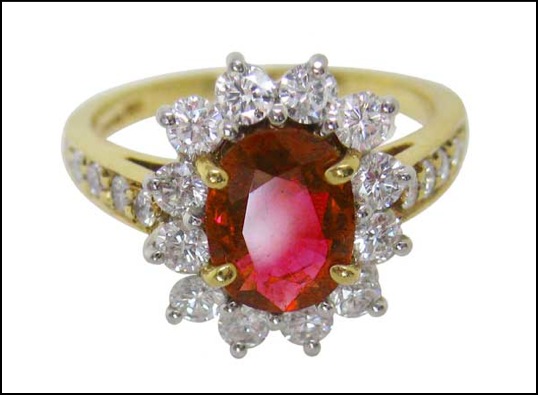Check out our Ruby board on Pinterest for more photos and info!

This classic ring style features a center ruby, surrounded by diamonds.
Ruby
Celebrated in the Bible and in ancient Sanskrit writings as the most precious of all gemstones, rubies have been the prized possession of emperors and kings throughout the ages. Ruby's inner fire has been the inspiration for innumerable legends and myths, and to this day, no red gemstone can compare to its fiery, rich hues. It was believed wearing a fine red ruby bestowed good fortune on its owner - although the owner must have already had good fortune enough to possess such a rare and beautiful gemstone!
Many people associate its brilliant crimson colors with passion and love, making ruby an ideal choice for an engagement ring. Ruby is the red variety of the corundum mineral species, while all other colors of corundum are called sapphire. This most sought after gemstone is available in a range of red hues, from purplish and bluish red to orangish red. Ruby is readily available in sizes up to 2 carats, but larger sizes can be obtained. However, in its finest quality, any size ruby can be scare. In readily available small sizes, ruby makes an excellent accent gemstone because of its intense, pure red color
Ruby is mined throughout Southeast Asia. While Thailand and Myanmar (Burma) produce exquisite examples of this gemstone that the ancient Sinhalese people called "Ratnaraj," the King of Gemstones.
Despite all the best efforts of gemstone merchants to use technology to enrich color, fine ruby is still exceptionally rare. After being extracted from the earth, rubies today are commonly heated to high temperatures to maximize the purity and intensity of their red hue. Impurities may also dissolve or become less noticeable after heating. However, heating will only improve the color if the gemstone already contains the chemistry required.
Occasionally rubies with small imperfections are permeated with a silicate byproduct of the heating process, which helps to make small fissures less visible. This enhancement, like heating, is permanent and rubies, whether enhanced or not, remain among the most durable of gems.*
*See our article on glass-filled rubies in our Buyer Beware section and on the Gemologist’s Page.
----------
In addition to
the above information from the AGTA and other sources, you
can find facts about these of gems and more at the
"Gems
and Gem Materials"
online course,
through the University of California-Berkeley's Department
of Earth and Planetary Science. The website is available
for the general public, and contains a wealth of
information for the budding gemologist and anyone
interested in learning more about gemstones. Hanna
Cook-Wallace has contributed to this site, which was
developed by Jill Banfield while teaching at the University
of Wisconsin.